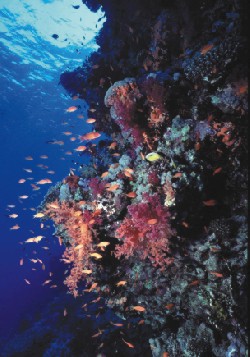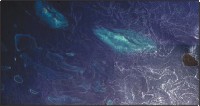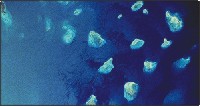psychological
disorders
By
Ishita Rahman
How can we distinguish normal from abnormal
behavior? How do we or can we really comprehend when we've crossed
the thin line that separates senility from sanity? And when we are
in dire need of help how much comfort are we provided?

When
discussing the topic of abnormality the first thing we need to do
is to distinguish between normal and abnormal behavior. Is abnormality
a deviation from the average or ideal? Or is abnormality a state of
personal discomfort or the inability to function effectively or maybe
the incapability to understand the difference between right and wrong.
But none of these can clarify what abnormality is. If these were the
actual definitions of aberration then ninety percent of our population
would be considered abnormal.
Abnormal behavior previously linked to superstition
and witchcraft, is now viewed with a more contemporary approach. Medical
perspective, psychoanalytic perspective, behavioral perspectives are
merely ways through which we interpret atypical behavior. The first
perspective assumes that physiological causes are at the root of psychological
disorders. Psychoanalytic perspective claims that psychological disorders
stem from childhood conflicts and behavioral perspective argues that
abnormal behavior are learned responses. Psychological abnormality
or disorders can be observed from a myriad of perspectives most of
which are nothing but gibberish to us; but the disorders are very
common in our day to day lives. Major disorders like anxiety disorders,
panic disorders, phobic disorders, obsessive compulsive disorder and
depression plague our lives. Depression teamed up with anxiety can
and does lead to suicide. Half of the adolescents who are victims
of substance abuse end up committing suicide.
In
our country where getting professional help is frowned upon about
17.6 percent adolescent need psychological help. The help provided
them whether sufficient or not can only be assessed by the readers.
In 2001 Bangladesh saw her first institute of mental health which
now provides psychotherapy, role model therapy, behavior guidance,
medicine and shock treatment to patients along with providing postgraduate
and training facilities to professionals. The treatment facilities
bring up another important point which is electric shock therapy.
Shock therapy whether sensible in Bangladesh remains to be answered.
Although shock therapy does cure problems in an efficient way any
physical damage occurred during the therapy is never compensated.
Like if a person happened to loose two front teeth in the process
of being shocked by four forty volts of current he would not be compensated.

The tribulations that trouble youths today are mainly
emotional disorders, substance abuse, conduct disorders and juvenile
delinquency, bipolar mood disorders and schizophrenia.
Stress and anxiety create emotional disorders. Substance
abuse is basically the addiction to drugs. Conduct disorder present
in about 3.2 % teenagers takes the form of deliberate self harm and
last but not least the cancer of nerves otherwise known as schizophrenia
affects more teenagers than we think.
All
these abnormalities instead of getting better take a turn for the
worse as society seldom wants to understand their pain. It is easy
to be judgmental and brand people who have abnormalities, lunatics.
Red
Sea Reefs

Crowded,
bustling, full of life: coral reefs are the big cities of the sea.
One-fourth of all known marine species live in reefs, including at
least 4000 varieties of fish and thousands of kinds of plants and
microorganisms. Reefs are critically important to our planet's ecosystem.
They're
also endangered. Pollution, global warming, cyanide fishing and coral
mining are among the threats. Even tourism can be a problem. We're
loving them to death. Resorts are built near reefs to attract snorkelers
and divers. Construction and human traffic, however, are bad news
for these delicate marine communities.
The
picture taken from the International Space Station shows more than
a dozen underwater reefs in the Red Sea. Six percent of all the world's
reefs are found in the Red Sea, and while these particular reefs look
well, 60% of the reefs in the area are thought to be in peril.
The
space station is a good place to study reefs. Four hundred km above
Earth, the crew can take pictures with both a wide field of view (capturing
entire reef communities) and high resolution. It's a wonderful combination.
This Red Sea image, for example, spans 85 km from side to side and
reveals details as small as 100 m. Other photographs of coral reefs
from the space station can discern details as small as 5.5 m.
And
that's not all.
When
ordinary Earth-observing satellites pass over a spot, it's usually
at the same local time. The sun is in the same part of the sky ...
flyby after flyby. Because their sensors look straight down the view
never changes.

The ISS is different. Each time the space station passes over some
location, like the Red Sea, the sun is in a different place in the
sky. With different lighting, the camera can capture different features.
Furthermore, astronauts are able to look out different windows of
the station, and they can look out each window at a variety of angles.
This allows humans in orbit to observe features in ways that satellites
can't.

A
remarkable feature of the image is the bright spot in the lower right--a
reflection of the sun overhead. It's called 'sunglint'. Snaking away
from that spot are silvery tendrils where sunlight is glinting from
oily surface films. The oils come from shipping traffic and the natural
biological activity of marine life. Wave motions and flows concentrate
the films into telltale patterns. By tracing their shape, scientists
can identify eddies, flow features between the islands, and the overall
water dynamics. Flowing water helps shape and sustain reefs, so this
is important information.
For
most Earth satellites, sunglint off the surface of the ocean is considered
a nuisance. It interferes with observations of underwater features.
However, glint can be used to interpret the physical properties on
the sea surface, and even infer wind speed and direction in a local
area.
Sunglint
a nuisance? It all depends on your point of view.
Compiled
by- Bonhomie
